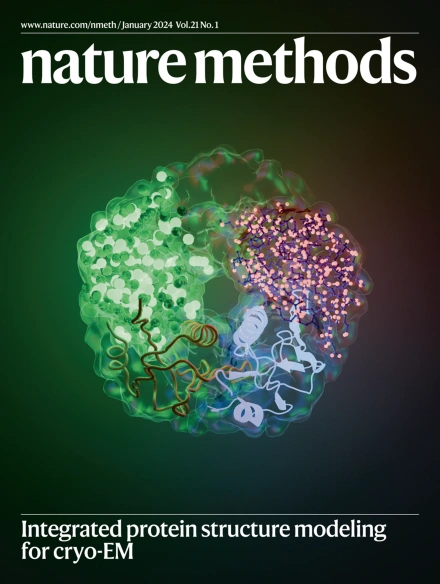利用4Pi-SIM在各向同性100纳米分辨率下阐明亚细胞结构和动力学。
IF 36.1
1区 生物学
Q1 BIOCHEMICAL RESEARCH METHODS
引用次数: 0
摘要
三维结构照明显微镜(3D-SIM)提供了出色的光学切片,与宽视场显微镜相比,在所有维度上的分辨率提高了一倍。然而,其较低的轴向分辨率导致模糊的细节在该方向和整体图像失真。在这里,我们提出了4Pi-SIM,这是I5S的实质性改进,它将3D-SIM与干涉显微镜协同使用,通过在照明和检测波前的干涉来实现各向同性光学分辨率。我们通过高保真成像不同细胞类型的各种亚细胞结构来评估4Pi-SIM的性能。此外,我们通过在数百个时间点上进行延时体积成像来证明其能力,实现了大约100纳米的3D分辨率。此外,我们还说明了它同时以两种颜色成像的能力,并在三维空间中捕捉紧密定位的细胞器之间的快速相互作用。这些结果强调了4Pi-SIM在阐明亚细胞结构和揭示纳米级动态行为方面的巨大潜力。本文章由计算机程序翻译,如有差异,请以英文原文为准。

Elucidating subcellular architecture and dynamics at isotropic 100-nm resolution with 4Pi-SIM
Three-dimensional structured illumination microscopy (3D-SIM) provides excellent optical sectioning and doubles the resolution in all dimensions compared with wide-field microscopy. However, its much lower axial resolution results in blurred fine details in that direction and overall image distortion. Here we present 4Pi-SIM, a substantial revamp of I5S that synergizes 3D-SIM with interferometric microscopy to achieve isotropic optical resolution through interference in both the illumination and detection wavefronts. We evaluate the performance of 4Pi-SIM by imaging various subcellular structures across different cell types with high fidelity. Furthermore, we demonstrate its capability by conducting time-lapse volumetric imaging over hundreds of time points, achieving a 3D resolution of approximately 100 nm. Additionally, we illustrate its ability to simultaneously image in two colors and capture the rapid interactions between closely positioned organelles in three dimensions. These results underscore the great potential of 4Pi-SIM for elucidating subcellular architecture and revealing dynamic behaviors at the nanoscale. The 4Pi-SIM microscope combines the benefits of structured illumination microscopy with 4Pi geometry for improved axial resolution, offering isotropic, multicolor super-resolution imaging of dynamic processes in living cells.
求助全文
通过发布文献求助,成功后即可免费获取论文全文。
去求助
来源期刊

Nature Methods
生物-生化研究方法
CiteScore
58.70
自引率
1.70%
发文量
326
审稿时长
1 months
期刊介绍:
Nature Methods is a monthly journal that focuses on publishing innovative methods and substantial enhancements to fundamental life sciences research techniques. Geared towards a diverse, interdisciplinary readership of researchers in academia and industry engaged in laboratory work, the journal offers new tools for research and emphasizes the immediate practical significance of the featured work. It publishes primary research papers and reviews recent technical and methodological advancements, with a particular interest in primary methods papers relevant to the biological and biomedical sciences. This includes methods rooted in chemistry with practical applications for studying biological problems.
 求助内容:
求助内容: 应助结果提醒方式:
应助结果提醒方式:


